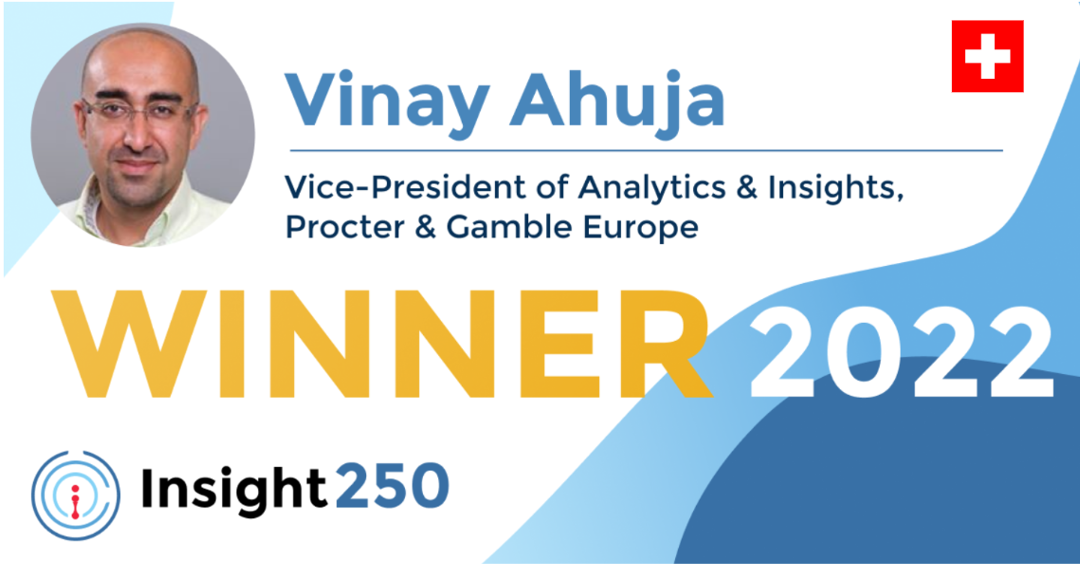The Evolution of Insights in CPG
Vinay and Crispin Beale present a deep discussion on the expanding impact of insights on the relationship between consumers, products, and brands and how technology advancements are elevating the role of market research.

Article series
Insight250
- The importance of business sense in research
- The role of humour in effective leadership
- The importance of ethics
- The importance of disruption in innovation and leadership
- The importance of Disruption in Innovation and Leadership Part 2
- The importance of Diversity & Inclusion
- The impact of colour
- Communicating insight with impact
- Insights on leadership, culture and polling
- The evolution of electric vehicles
- 2022 Top tips (part 1)
- 2022 Top tips (part 2)
- Maximising the potential of data
- The importance of flexible working
- Winners
- The importance of advanced analytics
- Judges for the 2022 Insight250 Awards announced
- The evolution from social listening to digital intelligence
- The Judges' Perspective
- The judge's perspective - part 2
- Insight Climate Collective
- Insights technology
- Understanding employee ownership
- Global insight perspectives
- Top Tips from our Leaders and Innovators
- The Evolution of Insights in the Food & Beverage Market
- The Evolution of Insights in CPG
- Neural Mechanisms Behind Consumer Decision-Making
- Celebrating and Elevating the Insights Industry
- The State of the Insights Industry
- Opportunities, challenges and threats that AI presents
- 2024 Insight250 Winners Announcement
- Connecting Brands and Consumers Through Insights
- The Importance of Human Insight and Attention
- The Elevating Role of Insights with Technology Innovation
- Haleon’s Insight Expert on Consumer Healthcare
- Insight from the Insight250: How AI is Impacting Qualitative Research
- How AI Tech is Doing the ‘Heavy Lifting’ for Insights
- Reviewing the top tips for 2025
- Google's Sarah Ashley on AI and revolutionising insights - Insights from the Insight250
- Beyond BI: The Future of Decision Intelligence for Insight Professionals
- The Advancement & Impact of Insights - An Insight250 Winners Series perspective with David Smith
- International Jury for the 2025 Insight250 Awards Announced
- Newly elected President, Anne-Sophie, on Revolutionizing the Impact of Insights
- Haleon's Litthya Baez on Enhancing Healthcare with Insights - Insight250 Winners Series
- Understanding the Insights of Consumer Decisions
- Moving Beyond Dashboards to Deliver Decisions with AI
- How AI is Transforming Insights
- How AI is Transforming Insights
- Five Years of Insight250: Elevating the Insight Industry
With so many exceptional professionals named to the Insight250, it seems fitting to tap into their expertise and unique perspectives across various topics. This regular series does just that: inquiring about the expert perspectives of many of these individuals in a series of short topical features.
This edition features Vinay Ahuja, Vice President of Analytics and Insights for Proctor and Gamble Europe.

Crispin: How critical is customer insight for global brands in today’s CPG markets?
VA: Insights have pivoted from brand-building hygiene to strong proteins essential for brand growth. We are now clearly in an environment where many individual experiences can be customized and where this is expected from providers and manufacturers; where consumers can and want to pinpoint and access exactly the solutions for their current needs and have them delivered in an efficient and often discreet manner, based on their preferences and behaviors. People expect – sometimes, they believe they are entitled to! – personalized experiences that meet their unique needs in moments that matter.
This is especially critical even more so today, because of widening say-do gap: what consumers say and what they actually do starts to diverge notably. By deeply understanding consumer behaviors, preferences, and pain points, brand builders can distill true insights – which brings us back to the realization that staying in touch with consumers and learning from them every day is essential.
At P&G, this idea drives our most strategic imperatives: to create and deliver experiences that grow the markets. Our category growth business model is a higher bar vs. simply growing market share and is anchored in superiority in all key touch points – product, package, communications, etc. And insights are immensely critical for innovation and to deliver our superiority model. Insights are truly the bedrock of our operations and success, guiding every aspect of our business from product development to communication and physical access to our brands. And I cannot emphasize enough the importance of local insights from consumers and shoppers in every context.
Crispin: Is using insights to drive commercial decisions increasing or decreasing in the sector, and why do you think that is happening?
VA: Unequivocally increasing; peaking, I would say. The growing availability of volumetric and longitudinal data and advancements in analytics capabilities enable more precise decisions, informed and data-driven. This always-on, real-time approach enables more agility and is responsive to the ever-changing and shifting consumer needs. The emphasis on personalized consumer experiences and the opportunity to increase return on investments further fuels the use of insights to guide commercial strategies.
At P&G, we have a long history of leveraging insights for commercial and product development decisions; indeed, our brand building is anchored around creating and delivering superior brand experiences for consumers, leveraging insights at every step of the way. Inсidentally, we are celebrating 100 years of the Analytics & Insights team at P&G this year. It was back in 1924 when we set up our Market Research department.
Since then, the underlying mission of what we do to deeply understand consumers has not changed – but our methods have evolved significantly, adding breadth and depth to the resulting data. Our work today touches many more aspects of brand building than it ever did. Real-time insights enable quick adaptation to marketplace changes, more effective resource allocation, and enhanced consumer satisfaction across the whole spectrum of experiences, including media consumption, retail, packaging – and, ultimately, product usage.
As the industry learns how to activate these capabilities to create and capture value, investments in this area will continue to grow, increasing the role of insights and analytics in implementing an effective business strategy yet more.
Crispin: What data types are used to develop insights for CPG brands and products?
VA: Literally anything we can lay our hands on – if it can be heard, read, observed, and measured, you can bet we are already using it. We are at an exciting stage in the evolution of our industry: thanks to technology, we can now measure what has yet been unmeasurable. We can track behaviors in real time that the consumer may even not be aware of, using data from smart devices and sensors; we can detect what machine settings a consumer may be using, for how long, etc., and match this information against his or her profile.
The increasing opportunity here is to be able to get an insight into what the consumer is doing, even if he or she may not be consciously aware of it: most everyday human decisions are made in the so-called ‘System One’ thinking, or autopilot, mode. The perception is equally important though because that guides the direction of the consumer’s choice.
For instance, we can now measure with the help of a variety of sensors, cameras, and AI – and with the appropriate permission of participating respondents of course – exactly how much water is being used or how much product is being dispensed at each stage of the wash process and then to pair this up with the consumer’s perceptions of their actions. This enables us to identify tremendous opportunities for improving the consumer’s washing experience.
Our mission requires us to continuously keep learning about how consumer habits and attitudes are evolving. The magic lies in two areas: our ability “to data-fy” – to measure, to capture, to codify what was not commonly measurable in the past; and second the integration of diverse data, to connect the ‘what’ with the ‘why’ and gain a holistic understanding of the emerging consumer landscape.
Crispin: Does increased competition and a changing customer base influence how CPG brands gather insights?
VA: “These days, the environment is so fast-paced – because of evolving customer preferences – that sometimes we need to run just to stay in place. New behaviors are often both a response to and a cause of shifts in the market context; by studying them, we can understand consumers in unprecedented ways and, importantly, offer them new opportunities to gain new or better experiences.
The moments of interaction, transition – and, more broadly, change – are rich territories for discovering points of friction and jobs to be done, which are critical for brands to understand.
It is important not to get distracted by competition, rather they should be a source of inspiration. Every success deserves respect.”
Crispin: Has the profile of P&G’s customers evolved over the last decade, and what factors do you believe are driving these changes?
VA: With a wide portfolio of daily use consumer products, P&G’s evolving consumer base largely mirrors the changing demographics in Europe. This reflects our ability to keep serving all consumers with relevant and meaningful and delightful experiences every day. And this is hard work because there have been very significant changes happening across Europe.
The demographics of Europe have undergone some notable significant changes over the last decade. I would broadly categorize these four key areas: population growth and decline, aging population, migration trends, and urbanization.
In Western Europe, countries like Germany, France, and the UK have seen modest population growth, driven primarily by immigration. Many countries in Eastern Europe, including Poland, Hungary, and the Baltic states, have experienced population decline due to low birth rates and emigration.
The last decade has also seen a shift in the generational composition of Europe, with an important decline in the proportion of Baby Boomers, a stable presence of Generation X, and an increasing influence of Millennials and Generation Z. The Generation Z, born between 1997-2012, were approximately 25% of the population in the early 2010s and now represent 30% of the population. In contrast, Baby Boomers, born between 1946 and 1964 are now approximately 17% of the population, down from 21% a decade ago, and with a higher concentration in the 65+ age group.
If you study the long 30-year history of demographics in Europe, we can see that the last decade was particularly important. Between 2015 and 2020 we have had the peak Impact of Baby Boomers in Europe. The period between 2010 and 2020 saw the most significant impact due to the retirement of the baby boomer generation, combined with sustained low fertility rates and increased life expectancy.
Then we have a lot of intra-European migration driven by economic disparities which have led to significant movement within Europe. And we have also seen increased immigration from outside the continent. The EU saw net immigration of about 1.5 million people annually over the past decade.
Finally, major cities across Europe have continued to grow due to internal migration and international immigration. Cities like London, Paris, Berlin, and Moscow have seen significant population increases. Conversely, many rural areas, especially in Eastern Europe, are experiencing population decline as younger people move to urban centers or abroad. As a result of all these factors, Europe has become more ethnically and culturally diverse particularly in urban areas, leading to multicultural environments.
To make the long story short, this is an exciting time to be in Europe precisely because of the important transformation underway. When there is change there is an opportunity to listen to and serve consumers better.
Crispin: What are the key differentiating factors for understanding your customers: frequency of use, demographics (gender, age, ethnicity), geographies (US vs. Europe), etc.?
VA: United we grow, divided we fail – rather than focusing on what differentiates us from each other, I would venture an opinion that there is greater value in understanding what unites us. We are all similar in that we are human, but each of us is also different and unique.
From a brand perspective, the key to finding the common ground is understanding the pain points or the problems to be solved. Getting down to brass tacks in terms of why, when, how, and what creates that pain or problem and then how, when, and what the customer might do to solve it can empower brands to develop experiences that appeal across generations or geographies.
We often find that some of our best-scoring creative content travels well across countries and often regions. We realized that when the underlying human insight is strong, broadly relevant, or universal, it can override consumer differences. For example, our Ariel cold-wash / wash-at-low-temperature communication finds broad appeal across countries.
Crispin: What role do insights play in attracting new customers and moving them from occasional customers to regular users and even brand advocates?
VA: “In for a penny, in for a pound – if our insight game is strong, once the customer enters our product universe, the gravitational pull hauls him or her in and keeps within. Brands and categories grow when they attract and grow new buyers and users, so that is what every business and brand builder must be obsessed with. Surely, nurturing the existing users to increase their engagement and consumption level is also important and can be accelerated, but it is more likely to happen organically. It takes a really big nudge to drive potential buyers into a category or service they are not using. Brands that lead the acceleration or growth of the category have a while do more for consumers and customers than those focused on winning market share. Insights should be anchored around uncovering new opportunities to learn what attracts new users to a category above anything else. And Insights for category growth is certainly our obsession at P&G.”
Crispin: Can you provide an example of a key insight that fundamentally changed a product decision or marketing strategy at P&G? How do you ensure such insights are effectively communicated and implemented across various departments?
VA: “Let me tell you how we fought a misconception about dishwashers – which, people believed, consumed ridiculous amounts of water and energy. Today, people are using more water in their homes than ever before; the average person spends about 15 seconds hand washing a dish, using half a gallon of water. On the other hand, running your dishwasher with as few as eight dishes already saves water. This insight led Cascade, P&G’s auto dishwashing brand in the US, to create a very impactful initiative called Do it Every Night to encourage water conservation in an unexpected way: running the dishwasher every night instead of washing dishes by hand.
Insights are too precious and their impact too powerful to be left to insight teams alone. Understanding consumers, customers, and shoppers must be everyone’s business in an organization, regardless of the function – when everyone is obsessed with understanding the job to be done or the problem the consumer is trying to solve, it becomes a shared objective. For P&G, Europe has delivered 12 consecutive quarters of 5% or higher topline organic sales growth, which is at the very top of our peer group in the industry. These sustained results would not be possible without the enterprise-wide obsession with consumers.
“Insights teams across the industry are surely able to lead the way proactively, but listening to and acting on their findings must be a shared responsibility. Translating insights into action is hard, it requires a developed business culture – and, sometimes, rethinking the role of insights for your business.”
Crispin: How do you see the role of insights evolving within the CPG industry?
VA: “In brief, we are increasingly able to measure what has been unmeasurable and do it faster. The CPG industry – just like in most sectors geared to retail consumption – is evolving towards greater integration of deeper human understanding capabilities and solutions with increasingly volumetric data that are often delivered in real-time, as well as technologies that enable us the capture and measure what has hitherto remained uncodified or unmeasurable (for example, with computer vision), as well as those technologies that can enable us to ‘connect the dots’ faster and better (with machine learning or Generative AI).
These advancements enable richer, more accurate, quicker analyses and, eventually, insights – and, hence, more personalized and dynamic marketing strategies. Insights capabilities that will increasingly drive innovation in the intersection of these spaces will enable CPG companies to stay ahead in a rapidly changing context. Insights professionals who are continually learning new skills, broadening and deepening their capabilities, will be growing ahead of those who are not.
“Additionally, there is a growing importance of ethical data usage and transparency, ensuring consumer trust and nurturing confidence among users. As the industry continues to innovate, insights leaders will need to play an increasingly strong role to ensure we maintain and build trust in the way we collect, use, and apply the data.”
HOT - TOPIC: Tackling challenges in a post-COVID world
Crispin: In a post-COVID world, many teams have reduced resources yet need to achieve more. Often marketing teams and others are hungry for data and attempt to conduct research or analyze data independently - sometimes misinterpreting or incorrectly analyzing data. Others are faced with growing and siloed data sets, tools that are no longer fit for purpose - we are in a world where insights and evidence are more important, yet results are needed more quickly.
Taking these areas below, how can companies tackle these challenges:
1. Overcoming Research Team Resource Constraints and Disconnected Tools:
VA: “Be aware that the exponential growth of growth of data and enable technologies is naturally driving up the demand for insights. When there is so much oil, the world is going to need a lot of refineries and highly efficient ones at that. Insights teams are going to have to be wary of selecting the problems and opportunities they take on. Which are the most pressing for their organization?
Is there a strong alignment across the organization on what the Insights teams will do and not do? In addition, organizations will need to invest in automation and integrated platforms that leverage advanced analytics and solutions to streamline data collection and analysis processes, reducing the manual workload for insights teams. Finally, all individuals must invest in their own development to be able to leverage technology to deliver projects better, faster, and cheaper.
2. Overcoming Siloed Survey Data:
VA: “Knowledge and data platforms that aggregate data from various sources into a unified view, enabling teams to analyze and cross-reference data comprehensively, are a must-have. We are also going to need and implement robust data governance practices to ensure consistency and accuracy. More fundamentally, we need to promote a culture of data sharing and collaboration to ensure that insights are disseminated and utilized effectively across the organization, driving cohesive and informed decision-making.”
3. Addressing Limitations of Dashboards and Complex Survey Analysis Tools:**
VA: “Always remembering what is behind every metric on a dashboard: an untold story of human motivation or behavior. What is the ‘why’ behind the ‘what’ or ‘when’? Scorecards and dashboards cannot do the thinking for us; they are as good as they are capable of motivating us to understand why the customer does or does not do something that makes the dashboard flash red or green or yellow and to learn what we might do differently. That requires continuous training, support, and opportunities for teams to go out and to listen to customers.”
TOP-TIP:
Crispin: What's your top tip to be a leader & innovator in our profession?
VA: “Lead and innovate in market research and consumer insights! Also, foster a culture of curiosity and continuous learning! Stay ahead of the emerging trends and technologies and encourage your team to do the same. Stay open to new data sources and technologies, learn new skills, methods and build your capabilities, while also questioning why we do what we do and finding what we might do that has not yet been done before.
Embrace a data-driven mindset but balance it with creativity and intuition. Collaboration is key—leverage diverse perspectives to generate innovative ideas and solutions.
Finally, remain consumer-centric in all you do; understanding how to solve specific consumer pain points and empathizing with your customers will always be the cornerstone of impactful consumer insights and analytics."
Crispin: Vinay, thank you for this in-depth conversation and for sharing your expertise - it is a fascinating time to see how the role of insights is expanding and the capabilities are advancing, particularly with consumer packaged goods.

Crispin Beale
Chairman at QuMind, CEO at Insight250, Senior Strategic Advisor at mTab, CEO at IDXCrispin Beale is a marketing, data and customer experience expert. Crispin spent over a decade on the Executive Management Board of Chime Communications as Group CEO of leading brands such as Opinion Leader, Brand Democracy, Facts International and Watermelon. Prior to this Crispin held senior marketing and insight roles at BT, Royal Mail Group and Dixons. Crispin originally qualified as a chartered accountant and moved into management consultancy with Coopers & Lybrand (PwC). Crispin has been a Board Director (and Chairman) of the MRS for nearly 20 years and UK ESOMAR Representative for c15 years. As well as being CEO of Insight250, Crispin is currently Worldwide CEO of Digital Communications Solution Agency, IDX. Crispin is also the Senior Strategic Advisor at mTab and the Chairman of QuMind and spent 4 years as Group President of Behaviorally where he was responsibile for the client & commercial teams globally. Crispin is a passionate advocate for blending human intelligence and technology to deliver innovation and leadership across organisations.
Article series
Insight250
- The importance of business sense in research
- The role of humour in effective leadership
- The importance of ethics
- The importance of disruption in innovation and leadership
- The importance of Disruption in Innovation and Leadership Part 2
- The importance of Diversity & Inclusion
- The impact of colour
- Communicating insight with impact
- Insights on leadership, culture and polling
- The evolution of electric vehicles
- 2022 Top tips (part 1)
- 2022 Top tips (part 2)
- Maximising the potential of data
- The importance of flexible working
- Winners
- The importance of advanced analytics
- Judges for the 2022 Insight250 Awards announced
- The evolution from social listening to digital intelligence
- The Judges' Perspective
- The judge's perspective - part 2
- Insight Climate Collective
- Insights technology
- Understanding employee ownership
- Global insight perspectives
- Top Tips from our Leaders and Innovators
- The Evolution of Insights in the Food & Beverage Market
- The Evolution of Insights in CPG
- Neural Mechanisms Behind Consumer Decision-Making
- Celebrating and Elevating the Insights Industry
- The State of the Insights Industry
- Opportunities, challenges and threats that AI presents
- 2024 Insight250 Winners Announcement
- Connecting Brands and Consumers Through Insights
- The Importance of Human Insight and Attention
- The Elevating Role of Insights with Technology Innovation
- Haleon’s Insight Expert on Consumer Healthcare
- Insight from the Insight250: How AI is Impacting Qualitative Research
- How AI Tech is Doing the ‘Heavy Lifting’ for Insights
- Reviewing the top tips for 2025
- Google's Sarah Ashley on AI and revolutionising insights - Insights from the Insight250
- Beyond BI: The Future of Decision Intelligence for Insight Professionals
- The Advancement & Impact of Insights - An Insight250 Winners Series perspective with David Smith
- International Jury for the 2025 Insight250 Awards Announced
- Newly elected President, Anne-Sophie, on Revolutionizing the Impact of Insights
- Haleon's Litthya Baez on Enhancing Healthcare with Insights - Insight250 Winners Series
- Understanding the Insights of Consumer Decisions
- Moving Beyond Dashboards to Deliver Decisions with AI
- How AI is Transforming Insights
- How AI is Transforming Insights
- Five Years of Insight250: Elevating the Insight Industry


